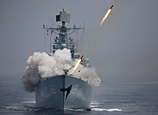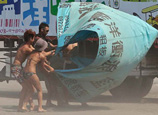
WUHAN, July 12 (Xinhua) -- Nearly 100 Chinese companies made this year's Fortune Global 500 list released earlier this week, but a closer look at the companies reveals problems that have long plagued China.
Ninety-five Chinese firms joined the ranks of the world's top companies, measured by their revenues in recent fiscal years.
China added 16 more companies to the list, narrowing the gap with the United States, which boasted 132 corporations this year.
Chinese companies accounted for 17 percent of the total revenues grossed by the top 500. This compares with 28 percent, or 8.6 trillion dollars, logged by U.S. companies.
More on Fortune lists:
• 95 Chinese companies make Fortune Global 500
• Forbes names China's 50 best CEOs
• Top 10 companies in the world 2013
However, Chinese firms on the list are mostly focused in traditional industries such as steelmaking, power generation, energy and chemicals -- sectors that are either grappling with overcapacity or are dominated by state-owned enterprises (SOE).
China's unbalanced economic structure is evident in the ranking.
"Very few Chinese companies on the list come from high-end manufacturing, the service industry or the technological sector," said Zhuang Ziyin, a professor with the Institute for Advanced Studies at Wuhan University.
Meanwhile, nine Chinese banks made the cut, followed by eight from the United States. The Industrial and Commercial Bank of China retained its spot as the world's largest bank, with its 2012 revenues reaching 133.6 billion dollars.
However, profits earned by nine banks, four insurance companies and 13 financial firms from China account for a whopping 56.5 percent of all the profits posted by 95 Chinese firms.
This suggests weak profitability for businesses in the real economy amid a global downturn and domestic structural woes.
China's economic growth slowed to 7.7 percent in the first quarter and a string of weak data released recently has pointed to milder expansion in the second quarter.
"Encouraging technological innovation and developing the real economy should be high on China's reform agenda," said Xu Zhengzhong, an economic professor at the Chinese Academy of Governance.
Chinese SOEs operating in the energy and resource sectors retained their prominent presence on the list. Sinopec, the China National Petroleum Corp. and State Grid Corp. of China joined a host of global resource and energy firms in establishing dominance in the top 10.
Many of these companies have also reported declining profits. Chinese steelmakers and mining companies like the China Minmetals Corp., Ansteel Group and Baosteel Group have seen their rankings plunge this year due to overcapacity and worsening financial results.
The declining trend will continue if China fails to engineer a transition toward high value-added and technology-intensive industries, Zhuang said, adding that resources and cheap labor cannot drive economic growth in a sustainable way.
Chinese technology companies are nearly absent from the list, underscoring the urgency for China to restructure its economy to a more consumption-based and technology-oriented growth model.
Only two Chinese tech firms -- Lenovo and Huawei -- made the cut, compared with a total of 44 tech companies on the list. Lenovo made a strong push to 329th from 370th a year ago, thanks to growing sales of personal computers and handsets, but still trails far behind Hewlett-Packard, the world's largest PC manufacturer, as well as tech heavyweights Apple and Samsung Electronics.
Meanwhile, telecoms equipment maker Huawei jumped to 315th from 351st a year ago, surpassing Stockholm-based Ericsson in the rankings with increased revenues and solid earnings propelled by smartphone sales.
The average debt to equity ratio for non-financial Chinese companies on the list came in at 4.42, much higher than the 2.79 seen in U.S. companies, a sign that Chinese companies are relying too heavily on borrowed money for business expansion.
While China's SOEs took up a growing share among the top 500, the country's private sector has largely missed the party.
Five private Chinese companies made the list last year, marking the debut of China's private sector in the rankings. Two more companies were added to the list this year: the Shenzhen-based Amer International Group and China Minsheng Banking Corporation.
"China's private sector should become a mainstay in global business competition and a key driver of China's economic growth going forward," Xu said.
















 China's Chongqing issues orange-coded alert of heat
China's Chongqing issues orange-coded alert of heat


![]()
